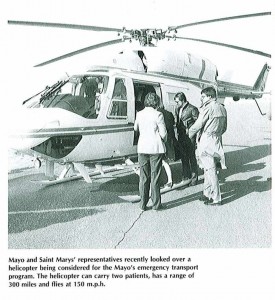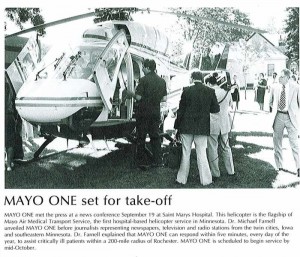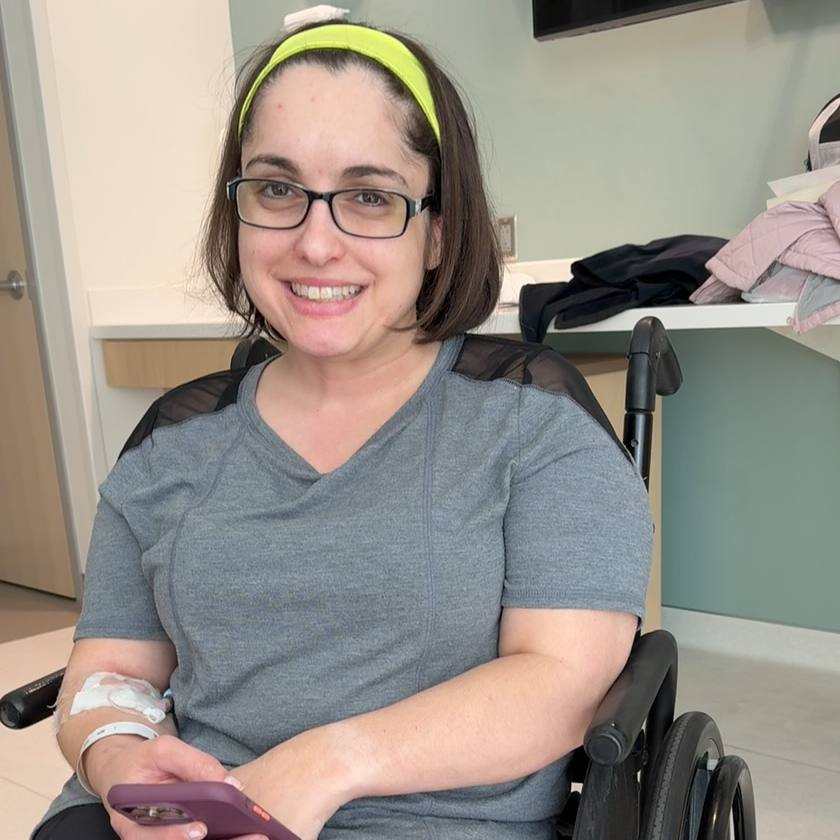-
#ThrowbackThursday: Mayo One Takes Flight 1984
This 1984 article first appeared in the publication Mayovox.
 Helicopter transport program approved; to be based at Saint Marys
Helicopter transport program approved; to be based at Saint Marys
Faster emergency care would be provided to critically injured or ill patients under a plan by Mayo Medical Center to implement a helicopter transport program. The plan for such a program has received initial Medical Center approval. It could be operational in the fall of 1984 if approved by the Minnesota Department of Health and the Rochester Zoning Commission.
Based on a helipad that would be built on the roof of the Mary Brigh Building at Saint Marys, the helicopter would be used to transport patients with life threatening injuries or illnesses in the 70-county region served by Saint Marys Emergency Room, encompassing southern Minnesota and northern Iowa.
The program will be operational 24 hours a day, seven days a week, and the helicopter will be available to respond on five minutes' notice to calls from physicians, hospitals and other emergency services providers.
Victims of motor vehicle accidents, cardiac emergencies, ill neonates and high risk pregnancies are examples of patients who will be transported. The s ervice will be limited to critically ill patients requiring rapid transport for sophisticated tertiary care. Officials project that about 500–800 patients annually would be candidates for helicopter transport, an average of 1–2 per day.
ervice will be limited to critically ill patients requiring rapid transport for sophisticated tertiary care. Officials project that about 500–800 patients annually would be candidates for helicopter transport, an average of 1–2 per day.
The most important element in consideration of this program, according to a report by Mayo's Emergency Care Committee, is the reduced mortality rate resulting from faster access to care. Time is of the essence, the report said, especially in the first 60 minutes following an accident — the so-called "golden hour" — when nearly 80 percent of the victims die who could have survived with faster emergency care.
One study of helicopter programs in the U.S. concluded that 20 percent of patients transported by helicopter would have died had they not had the service of the air ambulance. Another study by the University of California, San Diego, reported that the mortality rate for patients transported by helicopter was 52 percent less than for patients with similar injuries transported by the same institution by conventional land means.
The Emergency Care Committee report said that the death rate from accidents is much higher in the rural areas of southern Minnesota and northern Iowa than in the Twin Cities are due, for the most part, to greater distances separating the injured from hospitals.
According to the report, the Mayo helicopter transport program would serve as a regional resource complementing ambulance service currently available. It would provide a mobile, highly trained and well equipped emergency care/trauma team that could stabilize the crtically ill patients and transport them rapidly to the Medical Center. This would allow conventional ambulances to continue to service the local community rather than being tied up for an extended period in transport.
The Mayo helicopter would be operated under a lease agreement. Mayo would lease from the supplier a specially designed helicopter and three pilots would be on-duty around the clock. The helicopter would carry a specially-trained Mayo team comprised of two critical care-trauma nurse practitoners, life support equipment, supplies and communications systems.
The helicopter would be capable of transporting two patients at a speed of approximately 150 miles per hour. An elevator would be installed at Saint Marys to carry patients from the helipad to the Emergency/Trauma Unit and operating rooms in the Mary Brigh Building.
If the helicopter transport is ultimately approved for the medical center, it would join 64 such programs already in existence across the U.S. The nearest ones to Mayo are in Iowa City, Des Moines, Omaha and Milwaukee.







